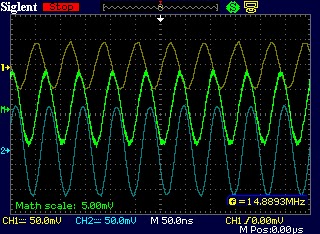Well,
Following my initial musings on the topic of baluns back here:
http://g0mgx.blogspot.co.uk/2013/04/a-what-un-ah-balun.html
I've run a simple test here today to try and see what, exactly, is going on with this commercial balun I have here. It's a BU-50 manufactured by Diamond Antennas (cost about 30 GBP).
As I stated before, I expected to feed a signal into this balun and see two signals 180 degrees out of phase with each other on the output (when measured against the input ground). Starting at about 500KHz, here's what we see:
So, this is pretty much as I expected. The yellow and blue lines are the two outputs - they are very close to being 180 degrees out of phase. The green smudge in the middle is the sum of the two signals - this is the effective cancellation effect we expect in the balanced feedline as they cancel each other out. Looking at it another way, if we subtract the two signals, we should get close to the original input, which we do:
So, the next thing I did was to start to increase the frequency of the input signal, here at 1.5MHz:
There is a noticeable reduction in the phase difference in the two signals at 1.5MHz, but I guess it's still close as the summation of the two (green) is still very close to nothing. Now, I increased the signal to 6MHz:
Then to 15MHz:
and finally, to 30MHz:
So, by the time we get to 30MHz, the signals seem to be considerably out of bonk - that technical expression means "not as expected".
What does this all tell me (Other than I need to go out more)? Not sure yet - the next thing to try is to wind some low power baluns myself and compare results. I certainly don't think this commercial balun is going to do what it's supposed to do across the HF spectrum.
Odd, egh?
Following my initial musings on the topic of baluns back here:
http://g0mgx.blogspot.co.uk/2013/04/a-what-un-ah-balun.html
I've run a simple test here today to try and see what, exactly, is going on with this commercial balun I have here. It's a BU-50 manufactured by Diamond Antennas (cost about 30 GBP).
As I stated before, I expected to feed a signal into this balun and see two signals 180 degrees out of phase with each other on the output (when measured against the input ground). Starting at about 500KHz, here's what we see:
So, this is pretty much as I expected. The yellow and blue lines are the two outputs - they are very close to being 180 degrees out of phase. The green smudge in the middle is the sum of the two signals - this is the effective cancellation effect we expect in the balanced feedline as they cancel each other out. Looking at it another way, if we subtract the two signals, we should get close to the original input, which we do:
So, the next thing I did was to start to increase the frequency of the input signal, here at 1.5MHz:
There is a noticeable reduction in the phase difference in the two signals at 1.5MHz, but I guess it's still close as the summation of the two (green) is still very close to nothing. Now, I increased the signal to 6MHz:
Then to 15MHz:
and finally, to 30MHz:
So, by the time we get to 30MHz, the signals seem to be considerably out of bonk - that technical expression means "not as expected".
What does this all tell me (Other than I need to go out more)? Not sure yet - the next thing to try is to wind some low power baluns myself and compare results. I certainly don't think this commercial balun is going to do what it's supposed to do across the HF spectrum.
Odd, egh?






















